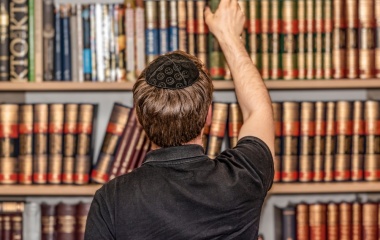
It is hard to think of a mitzvah that has undergone as much change over time as that of prayer. Originally, prayer was a spontaneous pouring out of one’s heart before G-d. One prayed when, what, how and for however long one may have wanted. This is especially true according to the mainstream view that the obligation of prayer is rabbinic in nature. But even according to the Rambam, who uniquely claims that prayer is of Biblical origin, that just means that there is an obligation to pray once a day. The time, length, and content of prayer[1] was left to each individual, as the Rambam himself notes (Hilchot Tefillah 1:3).
A perusal of the wide-ranging nature of sefer Tehillim, our go-to book when we need to pray, gives us an indication of the range of prayer that existed during the first commonwealth. This system held until the Babylonian exile when, as the Rambam laments, “No one was able, when he spoke, to express his thoughts adequately in any one language otherwise than incoherently” and thus, “Ezra and his court” i.e., the Anshei Knesset Hagedolah, established a routine of prayer (Hilchot Tefillah 1:4).
“Rabban Gamliel says: Each and every day a person recites the prayer of eighteen blessings. Rabbi Yehoshua says: akin to the shemoneh esrei, i.e., an abridged version. Rabbi Akiva says: If he is fluent in his prayer, he recites shemoneh esrei, and if not, an abridged version” (Brachot 28b).
A century and a half after the destruction of the Second Temple, some 600 years after the dissolution of the Anshei Knesset HaGedolah, we find a three-way debate as to the nature of our daily amidah[2]. Only Rabban Gamliel felt one must daven the full shemoneh esrei every day. Rabbi Yehoshua opted for a much shorter version where the middle section, consisting of first 12 then 13 supplications, was combined into one bracha, known as Haveineinu.
In an age where there was no printing press and manuscripts were available only to the wealthy, many people were illiterate, and one could hardly expect all to daven the entire shemoneh esrei.
As we recently discussed, Rabbi Yehoshua, who barely eked out a living, chastised Rabban Gamliel, who came from a very wealthy family, for being out of touch with the average Jew. Perhaps the debate above is a reflection of the great social and economic divides that existed amongst the Jewish people. Rabban Gamliel lived amongst a circle of the educated and hence, expected all to know how to fully daven. Living in a much different social milieu, Rabbi Yehoshua realized such was unrealistic—let us recall that in Talmudic times, prayer without proper kavanah, intent and focus, was deemed illegitimate[3]—and suggested a shorter and more realistic option. Rabbi Akiva, perhaps reflecting on his own life, suggested a compromise. For those who are “not fluent” in prayer—such as Rabbi Akiva himself, before the age of forty—a shortened version is all we can expect, whereas the more learned, such as the post-age-forty Rabbi Akiva, should daven the entire shemoneh esrei[4].
The Gemara discusses in great detail the bracha of Haveineinu detailing its exact language and the limitations on when it can be said. Interestingly, the exact language of the complete shemoneh esrei is never spelled out in the Gemara. Those who had the ability to daven the complete shemoneh esrei, “the prayer was fluent on their lips”, did not need an actual text, nor was such a text desirable. They were to daven from the heart, and a heart can’t be given a text.
It is in this vein that we can understand the continuation of the Mishna. Regardless of whether one davens the entire shemoneh esrei, an abridged form, or some combination thereof, “Rabbi Eliezer says: One whose prayer is kevah, fixed, his prayer is not supplication.” And what exactly is tefillat kevah? “Rabba and Rav Yosef said: One who is unable lechadesh bo davar, to say a novel idea” (Brachot 29b). Our prayers today cannot be the same as our prayers yesterday or the prayers we will say tomorrow. They can be similar—our lives are full of routine—but there must be something new every day! Each day is a new opportunity to express our innermost thoughts, to reflect on what we need today, to deal with a new challenge and to give thanks for a wonderful day.
Rabba and Rav Yosef are elaborating on Rav Oshia’s explanation of tefillat kevah as “one who sees prayer as a burden” and rushes to say the necessary words. One who cannot relate prayer to his day-to-day life, i.e., add something new, and instead just repeats what one said yesterday, will no doubt find prayer a burden.
It is for this reason that even as Rabban Gamliel realized that it was time for an “established order of the shemoneh esrei” (Brachot 28b), it has always remained a silent prayer. Words were provided—though as mentioned above, they are never actually spelled out in the Gemara—for those who needed them. But much preferred was for people to add their own personal prayers, something a little different every day. Rabban Gamliel provided the outline, but each person had to fill in the details. It is most unfortunate that this is so rarely done today.
It also serves to explain why, as far as I can tell, the Mishna never, and the Gemara rarely and most superficially, refers to chazarat hashatz, the communal repetition of the shemoneh esrei which, at least in Talmudic times, was how most people fulfilled the mitzvah of tefillah. Incapable of davening on their own, they would come to shul and answer amen to the prayers of the shaliach tzibbur[5]. This amazing display of dedication was a wonderful coming together for communal prayer, but such can never adequately replace personal prayer.
Prayer is a most difficult mitzvah, one compounded by the fact that we pray three times a day. It is so easy to make our prayers kevah, yet how tragic to invest so much time for something that is “a burden”!
Is it any wonder that, despite the prohibition of any and all interruptions between the blessing of Ga’al Yisrael and the beginning of the shemoneh esrei, our Sages instructed that we recite “O, G-d, open our lips and let our mouths recite your praises”? Praying that we able to pray is perhaps the most important of prayers.
[1] The Rambam does note that prayer had to consist of praise, supplication and thanksgiving. But the nature of these components was left to the individual.
[2] And just a few Talmudic lines earlier, the same Rabban Gamliel and Rabbi Yehoshua argued as to whether Ma’ariv was an obligatory or optional prayer, a debate which led to the removal of Rabban Gamliel from office.
[3] The Shulchan Aruch rules that we, too, must repeat the shemoneh esrei if it has been said without proper kavanah. However, since it is most likely that our second tefillah will be no better—and likely worse—in practice the ruling is not to daven over again (Shulchan Aruch, Orach Chayim 101).
[4] The line between one’s personal experiences and worldview impacting on one’s interpretation of the law—something legitimate and, in fact, impossible for humans to avoid—and issuing rulings to fulfill an irrelevant agenda (often disguised in the language of Jewish law, and even possibly done unintentionally) rendering those decisions null and void, can be a very fine one indeed. The halacha itself has built in “biases”; “for the sake of an agunah, the rabbis were lenient” (Yevamot 88b); it is best to “rely on Rabbi Shimon, i.e., a generally rejected view, in a time of need” (Brachot 9a) and many such others. Regarding prayer where its very nature is fluid and personal, it is most appropriate to rule more subjectively.
[5] If my limited knowledge of the history of piyyut, liturgical poem, is correct, the paytanim, who served as chazzanim, would compose piyutim each week to reflect appropriate themes, moods and needs. When one, even the learned, came to shul on Shabbat and Yom Tov, one did not know what “prayers” would be said that morning.



